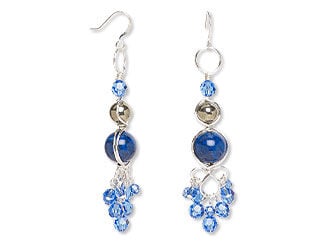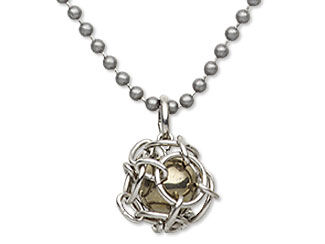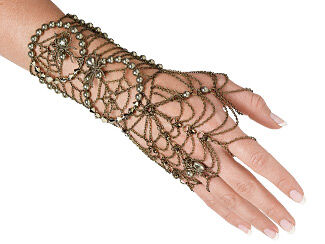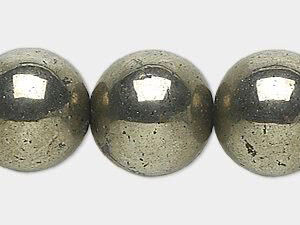Pyrite Meaning and Properties
Pyrite History
This golden-hued gemstone got its name for the Greek word πῦρ (pyr), which means "fire." Pyrite gemstones can be used to create sparks if they are struck against metal or another hard material. In fact, pieces of pyrite have been used in flintlock firearms to help produce the necessary spark. Pyrite gemstones were important to the production of sulfur and sulfuric acid, especially during the World War II era. Long before this use though, pyrite was valued by some Native American peoples as a healing stone. During the Victorian Age, pyrite was a favorite stone for creating carved rosettes, shoe buckles, rings and other decorative elements
Due to pyrite's gold color, luster and high specific gravity, this gem can be mistaken for gold, hence this famous moniker: fool's gold. Pyrite is also quite similar to another gem called marcasite, however marcasite does not have the same brassy hue.
What are the Metaphysical Properties of Pyrite?
Pyrite has long been valued as a strong protection stone that is said to shield the wearer from negative energy as well as environmental pollutants. Thus, this stone is thought to help promote physical well-being as well. Stimulating the second and third chakras, pyrite meaning is linked to strength of mind and willpower. Pyrite is also sometimes considered to be lucky, attracting wealth and abundance. Though not a birthstone, pyrite meaning is most commonly associated with the zodiac sign of Leo.
What is Pyrite Made From?
Though commonly found in Canada, Mexico, Namibia, Peru, Russia and Spain, pyrite can be found all over the world since it forms in all types of environments. Pyrite is a brassy-colored mineral featuring a metallic luster resembling gold. Pyrite has a chemical composition of iron disulfide (FeS2) and is the most common sulfide. Pyrite forms in some of the most interesting natural structures, including nearly perfect cubes and octahedrons. Another interesting formation is what is known as penetration twinning, where two or more crystals are intergrown. Pyrite deposits can contain small amounts of other minerals or gems such as cobalt, nickel, silver and true gold.
- Mineral Information: Sulfide
- Chemical Composition: FeS2
- Color: Brassy yellow
- Hardness: 6 to 6-1/2 (Mohs)
- Specific Gravity: 4.9 – 5.2
- Refractive Index: 1.73 – 1.83
How Do You Clean Pyrite?
Pyrite gemstones are fairly easy stones to keep clean. Simply use lukewarm soapy water and rinse. A soft cloth can also be used to restore luster, but it is not recommended to use anything that could leave scratches on the somewhat brittle surface of the stone. Do not steam, boil or clean in an ultrasonic machine. If cleaning pyrite jewelry with water, be sure to thoroughly dry any and all metal settings so as to prevent oxidation and rust.
Store pyrite stones and jewelry away from other materials to avoid marring the surface of the pyrite or causing scratches on less-hard materials.
Pyrite FAQ
Q: Why is pyrite called "Fool's Gold"?
A: Pyrite’s golden sheen has misled many into believing it was genuine gold, thus its moniker, “Fool’s Gold.”
Q: What is the difference between gold and pyrite?
A: In addition to having different chemical and crystalline structures, the most obvious difference between pyrite and gold is that pyrite is brittle and gold is malleable.
Q: Where is pyrite found?
A: Pyrite is found worldwide.
Q: Can pyrite tarnish or rust?
A: Pyrite is prone to both tarnish and rust.
Q: Is pyrite used for anything besides jewelry?
A: Historically, pyrite was used to create the spark for firearms. Today, pyrite is used in the production of sulfuric acid and as a component of lithium batteries and solar panels.
Designing with Pyrite
Pyrite has been used as a much more plentiful and cheap gold or marcasite replacement in jewelry and accessories, but pyrite is fun to design with for its merits, too. The warm, golden sheen is a favorite in men's jewelry for example. This provides a metallic tone that isn't overly shiny while pairing perfectly with black gems such as jet or for added textural intrigue, lava rock. This isn't to say only the men appreciate the understated shine of pyrite as women's jewelry can benefit from the subtle gold hue.
A Few Design Inspirations to Get You Started
Shop for Pyrite
**Please note that all metaphysical or healing properties listed are collected from various sources. This information is offered as a service and not meant to treat medical conditions. Fire Mountain Gems and Beads® does not guarantee the validity of any of these statements.
How did you like this resource? Your feedback helps us provide resources that matter to you most.
Copyright Permissions
All works of authorship (articles, videos, tutorials and other creative works) are from the Fire Mountain Gems and Beads® Collection, and permission to copy is granted for non-commercial educational purposes only. All other reproduction requires written permission. For more information, please email copyrightpermission@firemtn.com.




